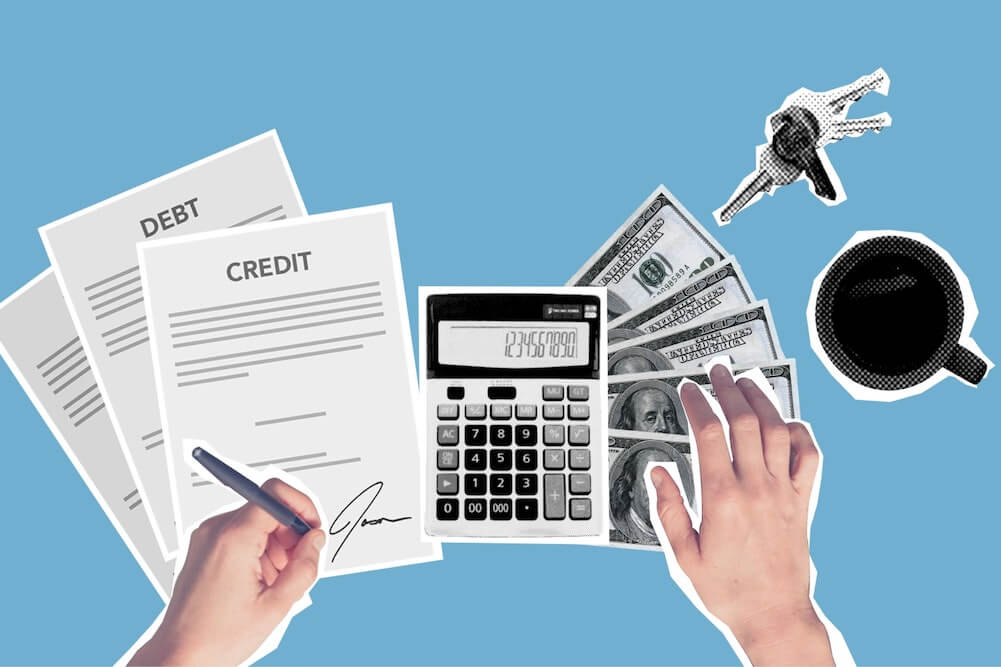Financing a vacation rental home requires a list of expenses, like monthly mortgage payments, taxes, insurance, and bills for maintenance, utilities, and management. Before investing in a property, it’s necessary to understand these costs and decide whether it’s a feasible plan.
In this article, you’ll learn about what vacation rental lenders look for, different types of loans, and mortgage rates. With this information, you’ll be able to manage your vacation rental financing without feeling overwhelmed or uninformed.
What Is a Vacation Rental Mortgage?
Simply put, a vacation rental mortgage is a loan from a bank (or a lender) to help you finance your property. Not only are you expected to pay this money back, but you’ll also need to pay an interest rate.
Rental property mortgage rates are usually at least 0.50% higher than primary residences. This rate depends on the type of property, your down payment, and your credit score.
Key Tips for Vacation Rental Property Financing
As previously mentioned, funding a vacation rental is not the same as financing your main home (or even your holiday home!). Here’s an overview of our ten main tips:
1. Prepare a clear overview
The first step in vacation property financing is understanding your motives behind the investment. Ask yourself the following questions:
- Why are you investing in a rental property? Is your primary goal to generate income or do you want a property that caters to your interests?
- What kind of property are you interested in?
- Where do you plan on investing?
Answering these questions and identifying your objectives will allow you to narrow down your search for properties.
2. Research the market
Before jumping into anything, you should also do thorough research of the market. Explore your options by calculating the income-generating potential of different locations and properties and keeping track of their key metrics. From the average cost of homes and seasonality to occupancy percentages and average daily rates, it’s essential to know all the factors that could affect your investment.
3. Learn about vacation rental lending
Qualifying for two mortgages isn’t something that everyone can do or afford. That said, learning about the different types of loans is a crucial part of financing your rental. The following are the loans you can apply for:
- Private money loans: As stated in its name, a private mortgage loan comes from a personal source of money. This could be fellow investors, friends, or family you know that might be willing to subsidize your vacation rental investment.
- 401(K) loans: This type of financing allows you to borrow money from your personal retirement savings account. This might be a good option for those who have a comfortable amount saved into their 401(K) or for anyone far away from retirement. You can take out up to 50% of your savings depending on your plan. You will have to pay interest on whatever you withdraw, but the amount goes back into your 401(K) account, unlike a traditional loan where the interest goes to the lender.
- Conventional loans: If you’ve already gone through a traditional mortgage route for your first home, then this won’t be anything new. The main requirements are a good credit score and a 20% down payment. The only additional factor they’re going to assess is if you can afford your first mortgage in addition to a second one. These are the most common loans for vacation rentals.
- Commercial loan for vacation rentals: This is an excellent choice for those looking to invest in some sort of multi-unit vacation rentals such as a bed and breakfast, villas, or a resort. It functions much like a regular installment loan but is often asset-based to protect the lender from a default on loan.
Rules and guidelines for lenders in the U.S. are set in place by Fannie Mae and Freddie Mac, two government-sponsored enterprises responsible for expanding the secondary mortgage market by securitizing loans in the form of mortgage-backed securities (MBS). The U.S. Congress created these mortgage companies to help boost the market back in the 90s and are now regulated by the FHFA.
4. Get pre-approved for a loan
A pre-approval gives you a significant advantage against your competitors and increases exposure to sellers. Pre-approval could mean purchasing power for those hidden gems well before other vacation rental owners find them. To get pre-approved for a loan, you’ll need the following documents:
- Employment verification
- Proof of income
- Asset verification
- A credit report
- ID (like a driver’s license and social security number)
5. Understand how to finance a loan
There are several ways you can finance a loan. Here are a few:
- Cash-out refinance: This is a great mortgage refinancing option in which an old mortgage is replaced with a new one for an amount larger than the remainder of the existing loan. Compared to the typical rent-and-term refinance option, cash-out often has a higher interest rate. When aiming for low interest, try to refinance when lending rates are low.
- Home Equity Lines of Credit (HELOC): This option borrows against the available equity in your home. Your house would be used as collateral for the line of credit. This option is only available for those who have equity in the current residence, meaning that the home’s value exceeds the amount owed.
- Getting a new loan: If building on your previous mortgage or extending a line of credit isn’t suitable for you, consider exploring the option of getting a new loan. A new loan would be completely independent of your primary home, so it could also save you peace of mind if you’re concerned about tying an investment property to your current home. Make a down payment of at least 20%
This is the unwritten rule for lenders. A 20% down payment helps lessen the risk on the lender’s side, but it’s also a great benefit for the borrower. Vacation rental financing is already more costly than a primary home mortgage, so the more money you put down, the better chance you have at a lower interest rate.
If you put less than 20 percent down, you run the risk of not only having a higher interest rate but also mandatory mortgage insurance. This isn’t always the case, but if your lender has it as a requirement, the costs can start to add up.
A larger down payment is always a good idea, but it should also be feasible. You don’t want to put your life savings on the line. Additionally, you’ll want to have some extra money outside of your loan that can cover costs for things such as advertising your property or using vacation rental management software.
Try to aim for around 20% to get the best interest rate for your vacation rental investment. If it’s not possible, a little less is okay too. Just be prepared for a higher monthly payment and a slight increase in fees.
6. Consider local banks
Shop local, eat local, and bank local too! Banking locally is not only the neighborly thing to do, but it’s also a wise choice for getting the most out of your vacation rental loan. Practically speaking, local banks sometimes have lower rates and better loan options for you than large lenders or online institutions.
Opting for a local bank might be a better choice for your budget, but it also helps your community which, in turn, helps your vacation rental business! Putting money back into your area helps stimulate the local economy and make it a better place for your vacation rental.
7. Ensure a strong credit score
The key to any good loan is a great credit score. At a minimum, you must have a credit score high enough to qualify for a loan, but a stellar credit score will improve the conditions of your loan. A good credit score could mean flexibility in the length of your loan, interest rates, and overall terms.
According to Credit Karma, the average credit score for buying a house is 717, but for second homes, it’s better to have an even higher score.
For first-time home buyers, there are many resources and assistance available to make the mortgage process more manageable. Vacation rentals aren’t treated the same, so it’s a good idea to have a strong credit score to offset any potential costs.
Some of the main factors that go into a credit score are:
- Payment history (35%)
- Amount owed (30%)
- Length of credit history (15%)
- Types of credit (10%)
- New credit (10%)
If you want to secure the best loan terms possible, consider some ways to improve your credit score. Checking your credit report for errors or becoming an authorized user on a credit card are easy solutions that quickly improve your score.
8. Keep a low debt-to-income ratio
Much like a good credit score, having a low debt-to-income ratio improves the likelihood of getting approved and having better loan terms. A good ratio is a two-fold benefit for both the lender and the borrower. This reduces the risk for lenders, but it also eases your worries about repayment.
The debt-to-income ratio, or DTI, is calculated by dividing the monthly debt expenses over your monthly gross income. The preferred DTI is around 36 percent, so you might want to find out your score beforehand and see if it falls in a suitable range.
9. Save some extra funds
Having some money put aside for a vacation rental property will benefit your investment in the short and long term. If you have some extra funds for an investment, you can expect a much quicker and smoother process in securing a loan.
In the long run, the more money you put aside, the quicker you can pay back your loan or the lower the interest rate will be. Once your loan is paid off, your vacation rental will be nothing but pure profit. Without a debt over your head, you can start to consider some of the other must-haves for a successful vacation rental business.
Additional Elements to Keep In Mind
Investing in a rental property is no small task, so make sure you’re checking off the necessary items before diving headfirst into a second home. A little bit of planning now will save you time, money, and energy in the future.
The timeline for financing
Getting a loan that works for you is a lengthy process. Research, applications, and approval all take time, so don’t expect to be able to finance a vacation home the very next day. In the beginning stages, you might want to estimate and prepare for how long it will take and plan for what you can do in the meantime.
Make the most of the waiting period by exploring renovation options, branding, and choosing the right vacation rental management software for your new business.
Research and keep your options open
We’ve outlined many financing options above for you to choose from, but remember that there’s a whole world of options available. Explore what options would suit you best. Spend some time looking at local lenders, big institutions, and online opportunities for your future investment.
Sometimes the best financing options are right in front of you, so take some time to explore any current investments or savings you might have to see if it’s possible to avoid loans altogether.
Key Takeaways
Making the decision to purchase a vacation rental is an exciting endeavor. You might already be filled with design ideas, ideal neighborhoods, and what you’re going to put in the welcome letter, but it’s essential not to rush the process. Financial planning is arguably the most critical part of making a rental property investment, so explore your options and take your time.
When you’ve finally made the big decision, you’ll need to get started on turning your second property into a profitable business. Get your name out there by building a website, listing your new property on sites like Airbnb and Vrbo, and branding your vacation rental.







